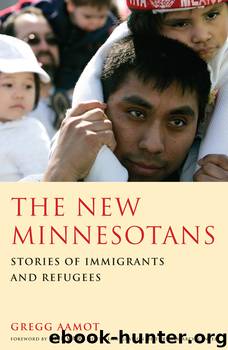The New Minnesotans by Gregg Aamot

Author:Gregg Aamot
Language: eng
Format: epub
ISBN: 978-0-929636-92-4
Publisher: Syren Book Company
Published: 2011-03-14T16:00:00+00:00
AP/World Wide Photos
Ahmed Wassie
LIVING IN DENIAL
Ethiopians Take on HIV/AIDS
Redwan Hamza, reclining deep in his chair and clasping his hands behind his head, brushed aside my complaints about the July heat wave. Wearing a black T-shirt and a big smile, he seemed in defiance of the sweltering temperature. “We make do,” he said with a laugh. “Nope. No A.C. in here!” A squeaky fan blew some stale air around as I tugged at my collar and felt the sweat trickling down my arms. Hamza ran a center called Oromo Community of Minnesota in the Cedar-Riverside neighborhood of Minneapolis, near the West Bank of the University of Minnesota campus. The fans and used furniture were further reminders of the shoestring budgets that held many immigrant community centers together.
Cedar-Riverside had an international flavor that seemed to fit Hamza and his Afro-centric organization. I was early for our meeting, so I took a stroll along the street, checking out some of the ethnic cafés and shops. There was an African grocery and coffee shop, a Mexican restaurant, and a Muslim meat market, to name just a few businesses that traded in ethnic fare. Old men who had probably lived most of their lives in Africa—and seemed starkly out of place in Minneapolis—visited on street corners. Women in scarves or body-covering burkas moved in and out of the stores.
Hamza was an ambassador for the neighborhood and the African refugee community. He was part proselytizer for Oromo (40 percent of Ethiopians are ethnic Oromos) and part community activist, promoting independence for Oromo one minute and doling out advice about local schools and hospitals the next. The community center offered training in “Oromo Culture, history, language, etc.,” according to its stated mission. But like the Somali center across the river in St. Paul, it was more of a catchall for African immigrant concerns. Workers at the center taught English, tutored immigrant children, and counseled elders who were struggling to adjust to American life. For Africans of all stripes who needed a place to gather and talk things over, Hamza’s center was the place to go.
It was also a crucial center in an important health struggle. In 2002, the state Health Department discovered a sobering trend: HIV and AIDS cases among African immigrants and refugees living in Minnesota were on the rise. Health workers had identified forty-six new HIV or AIDS cases among African immigrants in 2001—nearly twice the number of new HIV or AIDS cases reported among that group the year before. Many of the cases involved people who had contracted HIV in Africa and brought it with them, and their presence in Minnesota—especially if the virus continued to spread—promised to become a major health concern. As a longtime Ethiopian refugee, Hamza played an important role in educating and helping Ethiopians who were new to American culture. Now, the Health Department was asking for his help in fighting one of the great scourges of the times.
Cultural taboos would make it difficult to counter the trend. Ethiopians, reserved and conservative in many ways, rarely talked about AIDS or other sexually transmitted diseases.
Download
This site does not store any files on its server. We only index and link to content provided by other sites. Please contact the content providers to delete copyright contents if any and email us, we'll remove relevant links or contents immediately.
| Diaries & Journals | Essays |
| Letters | Speeches |
The Rules Do Not Apply by Ariel Levy(4861)
Bluets by Maggie Nelson(4473)
Too Much and Not the Mood by Durga Chew-Bose(4272)
Pre-Suasion: A Revolutionary Way to Influence and Persuade by Robert Cialdini(4145)
The Motorcycle Diaries by Ernesto Che Guevara(4012)
Walking by Henry David Thoreau(3893)
Schaum's Quick Guide to Writing Great Short Stories by Margaret Lucke(3319)
What If This Were Enough? by Heather Havrilesky(3274)
The Daily Stoic by Holiday Ryan & Hanselman Stephen(3231)
The Day I Stopped Drinking Milk by Sudha Murty(3159)
The Social Psychology of Inequality by Unknown(2939)
Why I Write by George Orwell(2874)
Letters From a Stoic by Seneca(2736)
A Short History of Nearly Everything by Bryson Bill(2629)
A Burst of Light by Audre Lorde(2546)
Insomniac City by Bill Hayes(2497)
Feel Free by Zadie Smith(2435)
Upstream by Mary Oliver(2341)
Miami by Joan Didion(2322)
